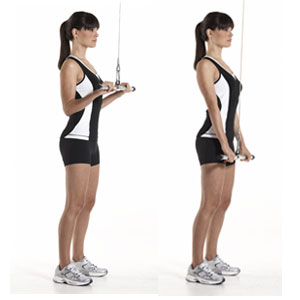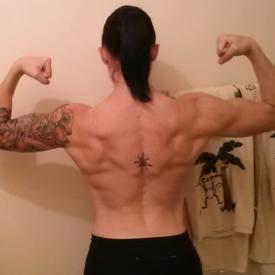Lower belly pooch
Replies
-
This content has been removed.
-
MamaBirdBoss wrote: »OP, sorry for the crap you're getting.
As people age or have babies, their pelvic floor and abdominal muscles often lose strength. You can have NO FAT AT ALL and still have your belly distended at the bottom. This happens due to general weakness or diastasis recti. Also, you may pee when you sneeze or cough or laugh. You often have back pain, too, in the lower back, or sciatica if your hips are slipping (sacroiliac joint--THIS SUUUUUCKS).
A bit about the pelvic floor:
https://en.wikipedia.org/wiki/Pelvic_floor
Primer on pelvic floor disorders:
http://www.uchospitals.edu/specialties/pelvic/faq/pelvic-floor-disorders.html
It also make certain kinds of female orgasms less likely, can cause prolapse of organs, and can even cause vaginal atrophy, in extreme cases.
A bit about diastasis recti:
http://www.webmd.com/baby/guide/abdominal-separation-diastasis-recti
IF YOU HAVE true diastatsis recti, you need to avoid ALL movements that strain the rectus abdominis until it's repaired. What a lot of people do is try to strengthen the rectus muscles by doing more sit ups/crunches/etc. Those are the wrong muscles. You want to strengthen your TRANSVERSE abs.
If you merely have a weak transverse abdominis, you can continue to work the abdominis recti, but realize that it won't fix the pooch.
If you do Pilates CORRECTLY (and avoid the rectus exercises if you need to), it's the hardest workout I've found for continually challenging your transverse abs. During Pilates, you're supposed to be drawing your belly button toward your spine the whole time.
You can also do stomach vacuums. Research diastasis recti fitness programs specifically if you need more guidance--there are several commercial programs out there.
A weak pelvic girdle (including the floor muscles but also muscles in the hips and so-called "core") can cause sacroilial instability, also, by increasing the movement of the joint when shear pressures are applied unevenly. I am CRAZY about Pilates for this!!!! Specifically search "pilates for IS instability," and you'll see a lot of results with specific routines. No more sciatica!!!!!!!
About IS instability:
https://en.wikipedia.org/wiki/Sacroiliac_joint_dysfunction
Complex compound lifts CAN help a lot with the strength of the whole pelvic girdle (if you can work your rectus). like squats (with weight) and deadlifts. They also help strengthen a lot of the other pelvic floor muscles if you do them right. However, a lot of people do then wrong and actually put STRESS on their pelvic floor, particularly. This can increase pelvic floor problems. During ANY lift, do not in any circumstances allow your stomach to bulge out, and don't feel like you might fart. Those are signs that you're not using your transverse abs or aren't using your pelvic floor muscles in sync with your other muscles (you're pushing down on the pelvic floor but not back against it--hence a feeling like you might fart).
I used to be fairly slim after kiddo number two. I had a 26" waist. But when I lay sideways, my guts sort of sloshed to the side, too. My rectus muscles were separated, and my transverse wasn't strong enough to provide the support it's supposed to. Working my transverse abdominis means that I'm a LOT fatter right now, but everything stays in place! Also, it's strong enough that I can finally lift weights again--before I was educated about how to reverse diastasis recti, I thought I would NEVER be able to lift again (because most movements increase separation).
Best of luck and TONS of love and support!
ummm... I'm turning 21 next month... no where near old, never had kids, only been sexually active for barely a year... so... I'm gonna say that's not my issue. Thanks, though!
OF course it isn't! Funny how people like to project and make it all about them.
You've been offered some great advice (before this response), you'll notice as you lose more, it will all come into place.0 -
PikaKnight wrote: »OP, if you want, you can still list the exercises the physical therapist gave you and we can find the bodyweight alternatives so you can try those out.
I don't know the names of any of them... which also makes it really hard to find pictures, I can try to describe though...
one of them I bend over and put one hand on a chair and dangle one arm with a dumbell and pull up to my chest.
Next is similar except I push my arm forward instead of up, and another pushing back instead.
The only other one I can think of off the top of my head is tying bands to a pull up bar and holding them at about eye-height and then pulling down to my hips while keeping my arms straight.
Both of those are mostly upper back (which I would love to work on more as well anyway).0 -
When I see the word Kegels, I always do one or two. Just in case.0
-
http://community.myfitnesspal.com/en/discussion/1161603/so-you-want-a-nice-stomach#latest
As I said earlier, "tone" is a combination of low body fat and adequate lean mass. A progressive lifting program like some of the ones mentioned before that include compound lifts are going to help your abs by forcing you to engage your core. Start with a program and consider adding additional abdominal work after a couple of months. Things like reverse crunches and hanging leg raise can strengthen your lower abs, but will make a bigger impact if you are also building a stable core through other means (such as compound lifts like bench press, deadlift, squats and overhead press).0 -
-
TheVirgoddess wrote: »When I see the word Kegels, I always do one or two. Just in case.
Sometimes I just do them just because, but mostly it just makes me need to pee0 -
OP - Good posture doesn't involve strength, and building strength doesn't guarantee good posture. There are plenty of muscular people with poor posture and back pain. To put it technically, posture is the job of the Type 1 muscle fibers, not the strength fibers (Type II). So try to get out of your head that strength exercises will fix your pooch, either visibly or functionally. Good posture is an endurance activity - it's something you have to practice all day long.
Google "transversus abdominis" and practice contracting it 24/7. It truly is as simple as pulling in your lower abs, like i said in an earlier post. If you do it often enough, the muscle will develop greater tone and maintain a tighter neutral position - but only if you get rid of any visceral fat under it.
By the way, if you have anterior pelvic tilt (google that term), stretch your hip flexors and lumbar muscles too (Youtube). That will facilitate contraction of your abdominals.
By the way #2 - try to ignore the negativity. 0
0 -
PikaKnight wrote: »OP, if you want, you can still list the exercises the physical therapist gave you and we can find the bodyweight alternatives so you can try those out.
I don't know the names of any of them... which also makes it really hard to find pictures, I can try to describe though...
one of them I bend over and put one hand on a chair and dangle one arm with a dumbell and pull up to my chest.
Next is similar except I push my arm forward instead of up, and another pushing back instead.
The only other one I can think of off the top of my head is tying bands to a pull up bar and holding them at about eye-height and then pulling down to my hips while keeping my arms straight.
Both of those are mostly upper back (which I would love to work on more as well anyway).
The first one sounds like a one arm dumbbell row. I'm not sure about the second version of that. The third sounds like tricep kickbacks.
The band one sounds like the band version of tricep pushdowns.
Do you want to look those up and see if that's right so far?0 -
TheVirgoddess wrote: »When I see the word Kegels, I always do one or two. Just in case.
I do them when I drive. Squeeze, hold to 20. Can't hurt.0 -
mantium999 wrote: »mantium999 wrote: »Just stopping by to LOL at the OP calling out rabbit and randomtai, of all people, as if they know nothing about strengthening of all the musclez. Needed a laugh today, thanks!!!
Here's someone saying they came to laugh at me.thorsmom01 wrote: »mantium999 wrote: »Just stopping by to LOL at the OP calling out rabbit and randomtai, of all people, as if they know nothing about strengthening of all the musclez. Needed a laugh today, thanks!!!
I needed a good laugh too.
. I bet the op could teach us something about strength training for sure ! (NOT)
as is this one.
I was laughing at your accusations toward 2 of the most knowledgeable members on these forums. But now I am laughing at you. Lower your shields, you might learn a thing or 2.
Exactly why I was laughing too. Because you made statements without knowing the facts . you said we didn't know about strength training, that's not true.0 -
This post has made a turn for the light-hearted just because of this pelvic-floor post. Thanks0
-
0
-
Honestly, just get started on a good lifting program.0 -
TheVirgoddess wrote: »
Thanks!0 -
-
And op seriously don't listen to a word about pelvic floor nonsense. Its just not even worth it0
-
TheVirgoddess wrote: »
With the back issues, I think yoga would help for sure. If you have Hulu, there is a series called Everyday Yoga. I've done the beginner episode (episode 2) and really like (which is saying a lot because I really don't like yoga very much).0 -
PikaKnight wrote: »TheVirgoddess wrote: »
With the back issues, I think yoga would help for sure. If you have Hulu, there is a series called Everyday Yoga. I've done the beginner episode (episode 2) and really like (which is saying a lot because I really don't like yoga very much).
I love doing yoga, but I find I'm either not strong enough or flexible enough for a lot of things... both of which I need to work on!0 -
PikaKnight wrote: »TheVirgoddess wrote: »
With the back issues, I think yoga would help for sure. If you have Hulu, there is a series called Everyday Yoga. I've done the beginner episode (episode 2) and really like (which is saying a lot because I really don't like yoga very much).
I love doing yoga, but I find I'm either not strong enough or flexible enough for a lot of things... both of which I need to work on!
Yeah, strength and flexibility don't necessarily come naturally. That's why we practice and train.0 -
If you gave birth to kids, good luck honey...0
-
flamingblades wrote: »If you gave birth to kids, good luck honey...
I gave birth to kids. My highest weight was 260 pounds.0 -
[quotMamaBirdBoss wrote: »OP, sorry for the crap you're getting.
As people age or have babies, their pelvic floor and abdominal muscles often lose strength. You can have NO FAT AT ALL and still have your belly distended at the bottom. This happens due to general weakness or diastasis recti. Also, you may pee when you sneeze or cough or laugh. You often have back pain, too, in the lower back, or sciatica if your hips are slipping (sacroiliac joint--THIS SUUUUUCKS).
A bit about the pelvic floor:
https://en.wikipedia.org/wiki/Pelvic_floor
Primer on pelvic floor disorders:
http://www.uchospitals.edu/specialties/pelvic/faq/pelvic-floor-disorders.html
It also make certain kinds of female orgasms less likely, can cause prolapse of organs, and can even cause vaginal atrophy, in extreme cases.
A bit about diastasis recti:
http://www.webmd.com/baby/guide/abdominal-separation-diastasis-recti
IF YOU HAVE true diastatsis recti, you need to avoid ALL movements that strain the rectus abdominis until it's repaired. What a lot of people do is try to strengthen the rectus muscles by doing more sit ups/crunches/etc. Those are the wrong muscles. You want to strengthen your TRANSVERSE abs.
If you merely have a weak transverse abdominis, you can continue to work the abdominis recti, but realize that it won't fix the pooch.
If you do Pilates CORRECTLY (and avoid the rectus exercises if you need to), it's the hardest workout I've found for continually challenging your transverse abs. During Pilates, you're supposed to be drawing your belly button toward your spine the whole time.
You can also do stomach vacuums. Research diastasis recti fitness programs specifically if you need more guidance--there are several commercial programs out there.
A weak pelvic girdle (including the floor muscles but also muscles in the hips and so-called "core") can cause sacroilial instability, also, by increasing the movement of the joint when shear pressures are applied unevenly. I am CRAZY about Pilates for this!!!! Specifically search "pilates for IS instability," and you'll see a lot of results with specific routines. No more sciatica!!!!!!!
About IS instability:
https://en.wikipedia.org/wiki/Sacroiliac_joint_dysfunction
Complex compound lifts CAN help a lot with the strength of the whole pelvic girdle (if you can work your rectus). like squats (with weight) and deadlifts. They also help strengthen a lot of the other pelvic floor muscles if you do them right. However, a lot of people do then wrong and actually put STRESS on their pelvic floor, particularly. This can increase pelvic floor problems. During ANY lift, do not in any circumstances allow your stomach to bulge out, and don't feel like you might fart. Those are signs that you're not using your transverse abs or aren't using your pelvic floor muscles in sync with your other muscles (you're pushing down on the pelvic floor but not back against it--hence a feeling like you might fart).
I used to be fairly slim after kiddo number two. I had a 26" waist. But when I lay sideways, my guts sort of sloshed to the side, too. My rectus muscles were separated, and my transverse wasn't strong enough to provide the support it's supposed to. Working my transverse abdominis means that I'm a LOT fatter right now, but everything stays in place! Also, it's strong enough that I can finally lift weights again--before I was educated about how to reverse diastasis recti, I thought I would NEVER be able to lift again (because most movements increase separation).
Best of luck and TONS of love and support!
ummm... I'm turning 21 next month... no where near old, never had kids, only been sexually active for barely a year... so... I'm gonna say that's not my issue. Thanks, though!
Your recognization and mentioning of her providing advice that is in no way applicable to your situation (shocked she did that, hehe) makes me retract my previous laughter. Fist bump to you!0 -
PikaKnight wrote: »PikaKnight wrote: »OP, if you want, you can still list the exercises the physical therapist gave you and we can find the bodyweight alternatives so you can try those out.
I don't know the names of any of them... which also makes it really hard to find pictures, I can try to describe though...
one of them I bend over and put one hand on a chair and dangle one arm with a dumbell and pull up to my chest.
Next is similar except I push my arm forward instead of up, and another pushing back instead.
The only other one I can think of off the top of my head is tying bands to a pull up bar and holding them at about eye-height and then pulling down to my hips while keeping my arms straight.
Both of those are mostly upper back (which I would love to work on more as well anyway).
The first one sounds like a one arm dumbbell row. I'm not sure about the second version of that. The third sounds like tricep kickbacks.
The band one sounds like the band version of tricep pushdowns.
Do you want to look those up and see if that's right so far?
Here are some pictures.
Dumbbell one arm row:
Tricep Kickback
Tricep Pushdown:
Are these the ones you are talking about?0 -
flamingblades wrote: »If you gave birth to kids, good luck honey...
What's your point? I gave birth to kids, too.0 -
flamingblades wrote: »If you gave birth to kids, good luck honey...
I gave birth to kids. My highest weight was 260 pounds.
shazam.0 -
PikaKnight wrote: »PikaKnight wrote: »OP, if you want, you can still list the exercises the physical therapist gave you and we can find the bodyweight alternatives so you can try those out.
I don't know the names of any of them... which also makes it really hard to find pictures, I can try to describe though...
one of them I bend over and put one hand on a chair and dangle one arm with a dumbell and pull up to my chest.
Next is similar except I push my arm forward instead of up, and another pushing back instead.
The only other one I can think of off the top of my head is tying bands to a pull up bar and holding them at about eye-height and then pulling down to my hips while keeping my arms straight.
Both of those are mostly upper back (which I would love to work on more as well anyway).
The first one sounds like a one arm dumbbell row. I'm not sure about the second version of that. The third sounds like tricep kickbacks.
The band one sounds like the band version of tricep pushdowns.
Do you want to look those up and see if that's right so far?
yes! Those all look like what I did0 -
The specific exercise that is directed for the pooch you are looking to rid of is a reverse crunch. Also bicycle crunches. If done properly it does work. Obviously you would include this with other exercise circuits/routines. But I'm not getting into that argument. Just wanna give a direct answer to your direct question.0
-
MamaBirdBoss wrote: »OP, sorry for the crap you're getting.
As people age or have babies, their pelvic floor and abdominal muscles often lose strength. You can have NO FAT AT ALL and still have your belly distended at the bottom. This happens due to general weakness or diastasis recti. Also, you may pee when you sneeze or cough or laugh. You often have back pain, too, in the lower back, or sciatica if your hips are slipping (sacroiliac joint--THIS SUUUUUCKS).
A bit about the pelvic floor:
https://en.wikipedia.org/wiki/Pelvic_floor
Primer on pelvic floor disorders:
http://www.uchospitals.edu/specialties/pelvic/faq/pelvic-floor-disorders.html
It also make certain kinds of female orgasms less likely, can cause prolapse of organs, and can even cause vaginal atrophy, in extreme cases.
A bit about diastasis recti:
http://www.webmd.com/baby/guide/abdominal-separation-diastasis-recti
IF YOU HAVE true diastatsis recti, you need to avoid ALL movements that strain the rectus abdominis until it's repaired. What a lot of people do is try to strengthen the rectus muscles by doing more sit ups/crunches/etc. Those are the wrong muscles. You want to strengthen your TRANSVERSE abs.
If you merely have a weak transverse abdominis, you can continue to work the abdominis recti, but realize that it won't fix the pooch.
If you do Pilates CORRECTLY (and avoid the rectus exercises if you need to), it's the hardest workout I've found for continually challenging your transverse abs. During Pilates, you're supposed to be drawing your belly button toward your spine the whole time.
You can also do stomach vacuums. Research diastasis recti fitness programs specifically if you need more guidance--there are several commercial programs out there.
A weak pelvic girdle (including the floor muscles but also muscles in the hips and so-called "core") can cause sacroilial instability, also, by increasing the movement of the joint when shear pressures are applied unevenly. I am CRAZY about Pilates for this!!!! Specifically search "pilates for IS instability," and you'll see a lot of results with specific routines. No more sciatica!!!!!!!
About IS instability:
https://en.wikipedia.org/wiki/Sacroiliac_joint_dysfunction
Complex compound lifts CAN help a lot with the strength of the whole pelvic girdle (if you can work your rectus). like squats (with weight) and deadlifts. They also help strengthen a lot of the other pelvic floor muscles if you do them right. However, a lot of people do then wrong and actually put STRESS on their pelvic floor, particularly. This can increase pelvic floor problems. During ANY lift, do not in any circumstances allow your stomach to bulge out, and don't feel like you might fart. Those are signs that you're not using your transverse abs or aren't using your pelvic floor muscles in sync with your other muscles (you're pushing down on the pelvic floor but not back against it--hence a feeling like you might fart).
I used to be fairly slim after kiddo number two. I had a 26" waist. But when I lay sideways, my guts sort of sloshed to the side, too. My rectus muscles were separated, and my transverse wasn't strong enough to provide the support it's supposed to. Working my transverse abdominis means that I'm a LOT fatter right now, but everything stays in place! Also, it's strong enough that I can finally lift weights again--before I was educated about how to reverse diastasis recti, I thought I would NEVER be able to lift again (because most movements increase separation).
Best of luck and TONS of love and support!0 -
PikaKnight wrote: »TheVirgoddess wrote: »
With the back issues, I think yoga would help for sure. If you have Hulu, there is a series called Everyday Yoga. I've done the beginner episode (episode 2) and really like (which is saying a lot because I really don't like yoga very much).
I love doing yoga, but I find I'm either not strong enough or flexible enough for a lot of things... both of which I need to work on!
You'll get there, though. I started barely being able to touch my toes. A few months later, I was doing this:
A year later, I'm pretty sure I'm not allowed to post photos of what I can do now
0
This discussion has been closed.
Categories
- All Categories
- 1.4M Health, Wellness and Goals
- 396.1K Introduce Yourself
- 44.1K Getting Started
- 260.8K Health and Weight Loss
- 176.3K Food and Nutrition
- 47.6K Recipes
- 232.8K Fitness and Exercise
- 448 Sleep, Mindfulness and Overall Wellness
- 6.5K Goal: Maintaining Weight
- 8.6K Goal: Gaining Weight and Body Building
- 153.3K Motivation and Support
- 8.2K Challenges
- 1.3K Debate Club
- 96.4K Chit-Chat
- 2.5K Fun and Games
- 4.4K MyFitnessPal Information
- 16 News and Announcements
- 18 MyFitnessPal Academy
- 1.4K Feature Suggestions and Ideas
- 3K MyFitnessPal Tech Support Questions









 https://www.youtube.com/watch?v=XeXz8fIZDCE
https://www.youtube.com/watch?v=XeXz8fIZDCE



